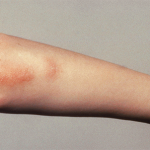For the majority of infected individuals who become symptomatic with Ebola, the persistence of and high levels of macrophage-derived cytokines, as well as serum ferritin, an established marker of sustained macrophage activation, have been shown to correlate with disease severity and mortality.10 Whether or not, and to what extent, a sustained and unregulated innate inflammatory response impairs the development of effective humoral and cytotoxic responses required to ultimately clear the virus remains uncertain. However, the contribution of sustained high levels of TNF to lymphoid apoptosis may account for the observed lymphopenia and associated absence of effective T cell-dependent humoral and cytotoxic T cell responses in the advanced stages of severe infection.
A Case for MAS
Significant hyperferritinemia (levels >20,000 ng/mL), as well as the clinical and laboratory features observed in severe Ebola and the other viral hemorrhagic fevers, are strikingly similar to what is commonly observed in patients who develop MAS in the setting of a variety of underlying illnesses, including rheumatic diseases (e.g., systemic juvenile idiopathic arthritis, systemic lupus erythematosus, adult-onset Still disease), immunodeficiency states, infection with herpes viruses (e.g., EBV, CMV, HHV-6, HSV) (see Table 1) or T cell leukemia.14 MAS is a frequently fatal complication of these disorders that results from a proinflammatory cytokine storm.14 Along these lines of thought, MAS (sometimes referred to as secondary hemophagocytic lymphohistiocytosis, or HLH) and hemophagocytosis noted on pathology specimens have already been associated with other hemorrhagic fever viruses, including Crimean-Congo and Dengue.15,16 Indeed, elevated serum ferritin levels have been reported in Dengue and associated with the severity of MAS/HLH manifestations in Crimean-Congo fever.12,13 It is, therefore, highly plausible to consider Ebola hemorrhagic fever as another likely trigger of MAS/HLH.
In prospective studies of family members having close contact with symptomatic Ebola virus disease patients, a number of individuals mount effective IgM & IgG responses to viral proteins in the context of confirmed viremia with genotype identical virus, yet do not develop symptoms.
Potential Therapy for Ebola Hemorrhagic Fever
Primary HLH, resulting from homozygous defects in lymphocyte cytolytic pathway genes, presents in infancy and is uniformly fatal unless treated with an aggressive etoposide-based protocol (HLH-2004) followed by bone marrow transplantation.14 By contrast, secondary HLH/MAS, typically presenting beyond infancy, is often treated with immunosuppressive therapy such as high-dose corticosteroids and cyclosporine A.17 Indeed, immunosuppression has successfully treated Dengue hemorrhagic fever (see Table 1).18 Recently, targeted cytokine inhibition has been shown to successfully treat HLH/MAS.19 Blockade of the proinflammatory cytokines, IL-1 and IL-6, have both proven beneficial in treating MAS/cytokine storm.17,20
